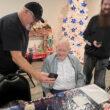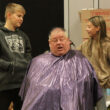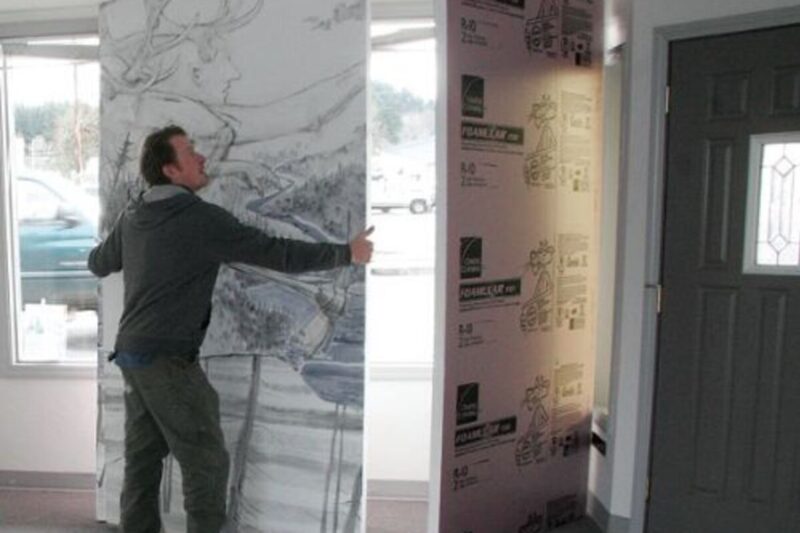Sean C. Morgan
Sweet Home and the petrified forest that lies beneath it were crafted by giants with antlers.
That’s just a fantasy story that an area artist came up with but visitors can see it depicted in the windows of 1344 Main St.
The new artwork taps into the area’s heritage to help spruce up the community’s streetscape. Two artists are displaying their work in two different storefronts in Sweet Home through Feb. 11 as part of the “Art in Rural Storefronts” program by the Corvallis Arts Center.
In addition to Sweet Home, one location in Philomath will feature special art, created specifically for those storefronts.
The Sweet Home locations include 933 Main St., Elite Performance Academy, the building owned by Sarah and Robert Shamek; 1344 Main St., a building owned by Ozzie Shaw that is currently empty; and the old liquor store in Philomath, 1604 Main St., owned by Debbie Thorpe.
The art was specifically created for each location, said Hester Coucke, the Arts Center curator. “The goal of the “Art in Rural Storefronts” project is to bring contemporary art installations to communities which lack spaces dedicated to contemporary/non-commercial artwork, and at the same time attract renewed attention to the properties involved.”
“The idea here is to improve the image of the storefronts and show activity in empty storefronts,” said Sweet Home Economic Development Director Brian Hoffman. “it’s a great partnership with the Corvallis Arts Center.”
The Arts Center was supported by an Arts Build Communities grant from the Oregon Arts Commission. The center collaborated with Rural Development Initiatives, the Sweet Home Economic Development Group, the Sweet Home Active Revitalization Effort and the Philomath Downtown Association to create art projects.
The original idea was to have one art installation, Hoffman said, but it’s important to get a critical mass and show what it can do for the streetscape. He hopes local artists will be able to do something similar.
“It’s a fun project,” Hoffman said. “It’s good for Sweet Home. It gives us some attention in the arts community.”
Sweet Home and Philomath community members selected artists from a pool of installation art specialists.
“Locally, our role was to select two different artists to participate in two separate storefronts,” said Hoffman said. A committee including Hoffman, Gail Gregory, Jo Ann McQueary, Jane McQueen and Judy Dean selected Gale Everett and Andy Myers to design art projects for Sweet Home.
Once selected, the artists refined their designs to the surroundings and history of Sweet Home and Philomath, or making them “fit” in the specific location the artists were assigned.
In the windows of 933 Main St., Everett created an installation titled “Unseen Natives,” commenting on native fish living in the muddy waters of the flooded fields and agricultural ditches in the Willamette Valley.
She has built fish from many paper squares, representing the acres of land dedicated to agricultural production. In keeping with other installation work she has done, Everett uses wire frame forms covered in paper.
Multiple windows of 1344 Main St. are taken up with a diorama of drawings by Myers. Each window shows a different scene. One window shows the fantastical version of the creation of the petrified forest Sweet Home is built on. Myers’ work is drawn on foam board mostly in black and white. He includes a single additional color on several panels.
“It’s kind of a tall-tale take on the petrified forest under Sweet Home,” said Myers, an Albany resident who teaches at Oregon State University and Linn-Benton Community College. He taps a fantasy creation tale with antlered giants building the Sweet Home valley.
In a series of panels, giants pour the minerals that become the petrified forest, and then they carve and design the landscape above, the trees and the South Santiam River. Ultimately, the giants place the buildings into Buckhead and Mossville, which were the communities that eventually became Sweet Home.
In the piece, the Buckhead Saloon features a set of antlers above the entrance. The antlers inspired Myers’ depiction of the giants.
While he was researching Sweet Home’s history, Myers found out it was built on a petrified forest, he said. “The single color is definitely my style. It’s mostly black and white anyway.”
It also fit with the old photos he saw of Sweet Home, he said. The single color is something he often adds to his work.
“I think it makes the black and white a little more interesting,” Myers said. It makes it look a little more fantastic and brings the black and white to life.
“It’s a great way to attract attention to a space,” Myers said. “In a small town, it’s unique.”
For a building that’s on the market, it’s a subtle way to draw attention, said Myers, who grew up in a small Eastern Oregon town, LaGrande. “Maybe it gets people paying attention to a space they’d normally pass on by. The whole idea is putting more contemporary work into a small town.”
At 1604 Main Street, Philomath, Avantika Bawa transformed the old liquor store with a bright color vinyl to punctuate the building’s typical 1970s design. She sees the use of the vinyl lines and fields as a drawing or painting on a large scale, creating a transformed experience of the interior and exterior of the building.
The title “Cocktail # ff080” refers to the magenta color as its color-code, as well as the history of the building being a liquor store.
For more information about the art, visit theartscenter.net, andrewrmyers.com, avantikabawa.net and stickstonesnpaperstew.com.
A reception is scheduled for Jan. 18 at the Sweet Home Economic Development Group offices, 401 Main St., Suite D.





